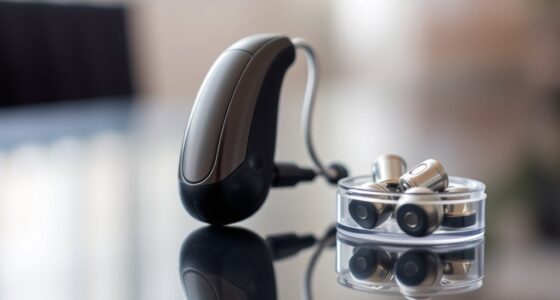Frequency lowering is a technology in hearing aids that shifts high-pitched sounds to lower frequencies, helping you hear speech sounds like “s” or “f” more clearly, especially if you have high-frequency hearing loss. It improves speech understanding, sound clarity, and listening comfort by making sounds more natural and easier to perceive. While it can take some adjustment, understanding how it works can help you get the most benefit—if you continue exploring, you’ll discover even more about its benefits.
Key Takeaways
- Frequency lowering shifts high-frequency sounds to lower frequencies to improve speech understanding for those with high-frequency hearing loss.
- It uses techniques like transposition and spectral compression to make sounds more audible and natural.
- Benefits include better speech clarity, environmental awareness, and listening comfort, especially for consonants like “s” and “f.”
- Users may experience adaptation challenges, such as altered sound perception and localization, which improve over time.
- Regular audiologist adjustments optimize device performance and ensure the technology effectively enhances auditory experiences.
What Is Frequency Lowering and How Does It Work?

Frequency lowering is a technique used in hearing aids to make high-frequency sounds more accessible to users with high-frequency hearing loss. It works by shifting sounds at higher sound frequencies down to a lower range your auditory perception can better interpret. This process guarantees that important sounds, like speech consonants, aren’t missed due to limited hearing sensitivity at higher frequencies. When sound frequency is lowered, your brain receives a clearer, more complete audio signal, enhancing speech understanding and environmental awareness. Fundamentally, frequency lowering helps bridge the gap between the sounds you struggle to hear and what your auditory system can process comfortably. Additionally, understanding the specific hearing loss profile can help optimize the effectiveness of frequency lowering technology. By improving access to high-frequency sounds, this technology supports more natural hearing experiences and better communication.
Types of Frequency Lowering Technologies
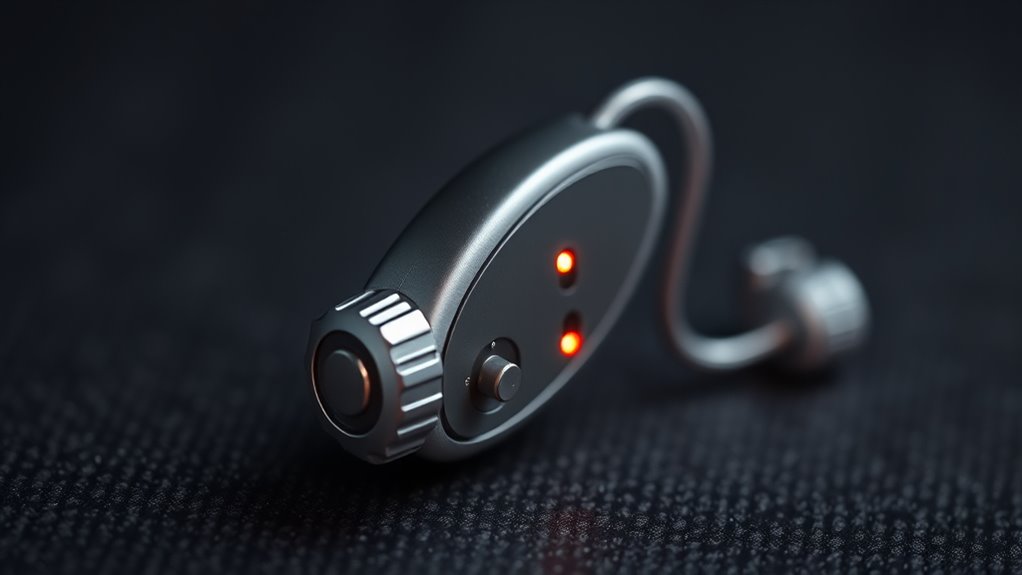
There are different types of frequency lowering technologies designed to make high-frequency sounds more audible. Two common approaches are frequency transposition techniques and spectral compression methods. Understanding how each works helps you choose the best option for your hearing needs.
Frequency Transposition Techniques
When it comes to frequency transposition techniques, different methods aim to make high-frequency sounds more accessible by shifting them to lower, more audible ranges. This helps improve auditory perception and sound localization for users with hearing loss. Transposition typically moves sounds an octave or a few notes lower, preserving speech cues. Here’s a quick overview:
| Method | Description | Benefits |
|---|---|---|
| Full-band transposition | Shifts all high frequencies uniformly | Maintains spectral relationships |
| Multi-band transposition | Transposes specific frequency bands | Improves clarity in complex sounds |
| Harmonic transposition | Adjusts harmonic components selectively | Enhances speech intelligibility |
| Dynamic transposition | Varies shift based on sound context | Preserves natural sound cues |
| Fixed transposition | Consistent shift regardless of input | Simplifies processing |
Spectral Compression Methods
Spectral compression methods are a set of frequency lowering technologies that reduce the spectral gap between high and low frequencies, making sounds more audible for individuals with hearing loss. Unlike other methods, spectral compression shifts high-frequency sounds into a narrower lower-frequency range without distorting the overall sound structure. This approach can improve pitch perception by preserving the harmonic relationships in speech and music, helping you distinguish different sounds more clearly. It also enhances music appreciation, especially for high-pitched instruments or melodies that might otherwise be inaudible. Because spectral compression maintains the relative spectral balance, it offers a more natural listening experience while making important cues accessible. This technology is particularly useful for users who struggle with high-frequency sounds, supporting better communication and enjoyment of music. Additionally, advancements in frequency lowering technologies continue to improve the effectiveness and naturalness of sound perception for users.
Identifying High-Frequency Hearing Loss

How can you tell if you have high-frequency hearing loss? You might notice difficulty understanding speech, especially consonants like “s” or “f,” or find high-pitched sounds seem muffled. Audiology training helps professionals identify these signs through hearing tests that measure your ability to detect sounds at various frequencies. If you struggle with sounds in the higher range, it could indicate high-frequency loss. Music therapy specialists also observe how your perception of treble sounds differs from others. Recognizing these signs early allows for proper diagnosis and intervention. Regular hearing assessments are essential, especially if you notice challenges in understanding speech or enjoying music. Identifying high-frequency loss is the first step toward effective solutions, including frequency lowering technology in your hearing aids. Hearing test accuracy can be improved with advanced audiological equipment to better detect high-frequency deficits.
Benefits of Using Frequency Lowering in Hearing Aids

Using frequency lowering in your hearing aids can considerably improve your ability to recognize speech and understand conversations. It also clarifies sounds that might otherwise be muffled or difficult to hear. As a result, you’ll experience more comfortable and natural listening, even in challenging environments. Incorporating vetted technologies ensures safety and effectiveness in your hearing aid experience.
Improved Speech Recognition
Have you ever struggled to understand speech in noisy environments or when someone is speaking softly? Frequency lowering enhances your auditory perception by making high-frequency sounds more accessible. This improvement leads to clearer speech recognition, especially for consonants like “s” and “sh” that are essential for understanding. Here are three key benefits:
- Better identification of speech sounds in complex settings
- Enhanced ability to distinguish speech from background noise
- Improved sound localization, making it easier to identify where sounds are coming from
- Incorporating Dog names can also help personalize auditory cues and make sound recognition more intuitive for users.
Enhanced Sound Clarity
Frequency lowering substantially enhances sound clarity in hearing aids by making high-frequency sounds more audible. This improvement helps you perceive speech more clearly and experience richer musical fidelity, as subtle details in music become easier to detect. By reducing the impact of environmental noise, frequency lowering allows you to focus on important sounds without being overwhelmed by background distractions. You’ll notice that speech sounds are sharper and more distinct, even in noisy environments. This clarity boost ensures you don’t miss out on conversations or musical nuances, enriching your overall listening experience. With better sound clarity, you can enjoy a more natural hearing sensation, making everyday interactions more comfortable and engaging. Additionally, understanding the types of audio content you are listening to can further enhance your hearing aid experience.
Better Listening Comfort
Ever wonder how hearing aids can make listening more comfortable? Frequency lowering can greatly improve your experience by reducing strain caused by environmental noise and enhancing music appreciation. Here’s how it helps:
- It minimizes the need to constantly adjust volume, making conversations and sounds more natural.
- It reduces the irritation from background noise, so you can focus on what matters.
- It improves your ability to enjoy music, capturing richer tones and details that might otherwise be lost.
- Using vetted technology ensures that the adjustments are effective and reliable, enhancing overall listening comfort.
How Frequency Lowering Enhances Sound Clarity
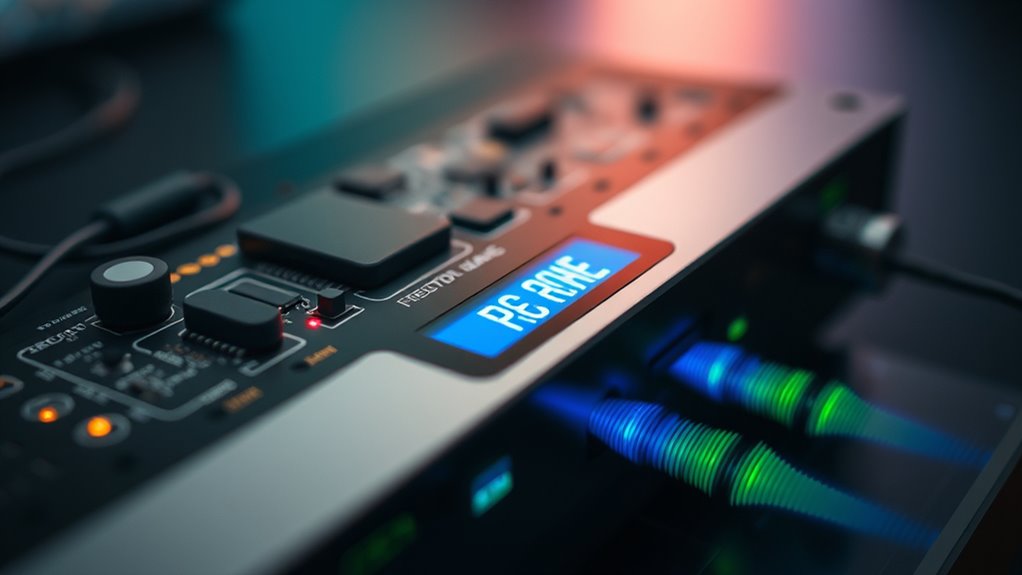
When frequency lowering is applied, it shifts higher-pitched sounds to lower frequencies where they are easier to hear clearly. This process enhances sound clarity by making speech and important environmental cues more accessible. With clearer high-frequency sounds, your ability to enjoy music appreciation improves because details like cymbals or vocals become more distinct. Additionally, it helps reduce the impact of environmental noise, which often masks high-frequency sounds, making conversations and sounds more intelligible despite background clutter. By bringing previously inaudible sounds into your hearing range, frequency lowering creates a richer, more natural auditory experience. This makes everyday environments less overwhelming and allows you to focus better on what matters, improving your overall understanding and enjoyment of sound. Understanding industry trends and the importance of professional equipment can further optimize the effectiveness of frequency lowering.
Potential Challenges and Limitations
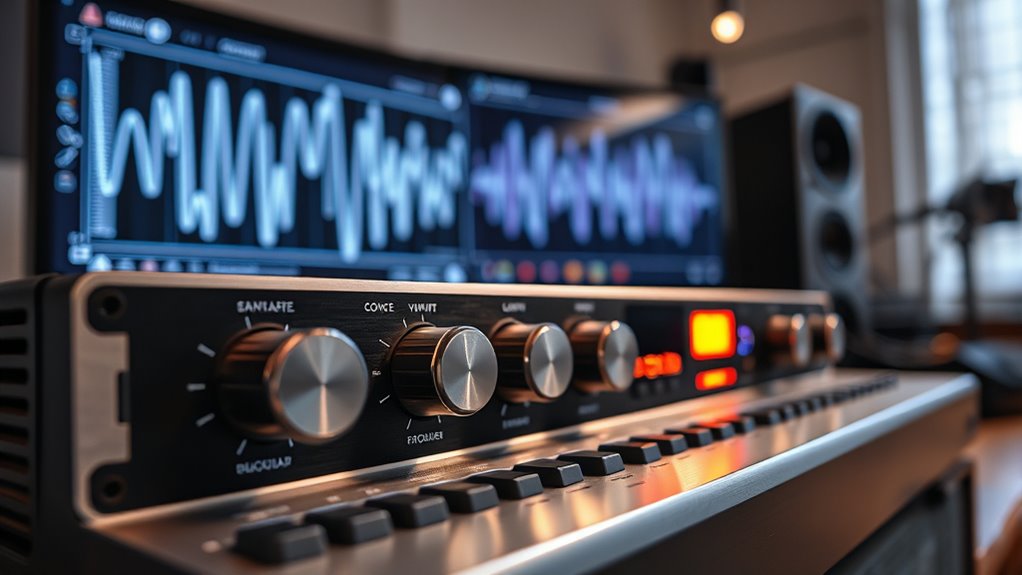
While frequency lowering can considerably improve sound clarity, it’s important to recognize that it also comes with some challenges. These include:
- Altered auditory perception, which may make sounds seem unnatural or less detailed.
- Reduced accuracy in sound localization, making it harder to identify where sounds are coming from.
- Possible distortion of speech cues, affecting comprehension in complex listening environments.
- Regular maintenance is essential to ensure optimal performance and minimize potential issues with the device.
These issues can impact how you perceive sounds and interpret spatial cues. Some users find that the processed sounds feel less natural, which may require an adjustment period. Additionally, difficulties with sound localization could affect safety and awareness in busy settings. Understanding these limitations helps you set realistic expectations and work with your audiologist to optimize your hearing experience.
Adjusting to Frequency Lowering: What Users Should Expect
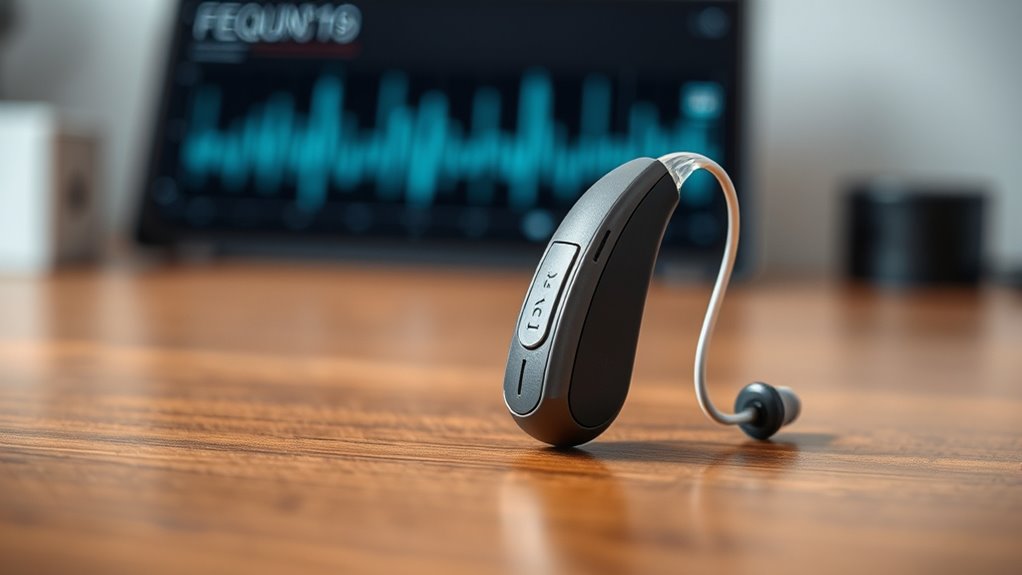
Adjusting to frequency lowering may take some time as your brain learns to interpret the modified sounds. At first, you might notice that music sounds different or less natural, but with patience, your brain adapts, and your music appreciation improves. You may also find background noise more manageable, as frequency lowering helps reduce the impact of high-frequency sounds that often cause discomfort or difficulty understanding speech. During this shift, it’s normal to experience some unfamiliarity or slight confusion with certain sounds, but these feelings typically fade as your auditory system adjusts. Consistent use of your hearing aid and open communication with your audiologist can speed up this process. Additionally, understanding how the auditory system adapts can help set realistic expectations during this adjustment period. With time, many users find that their hearing becomes more comfortable and their ability to enjoy music and conversations enhances.
Comparing Frequency Lowering to Other Hearing Aid Features
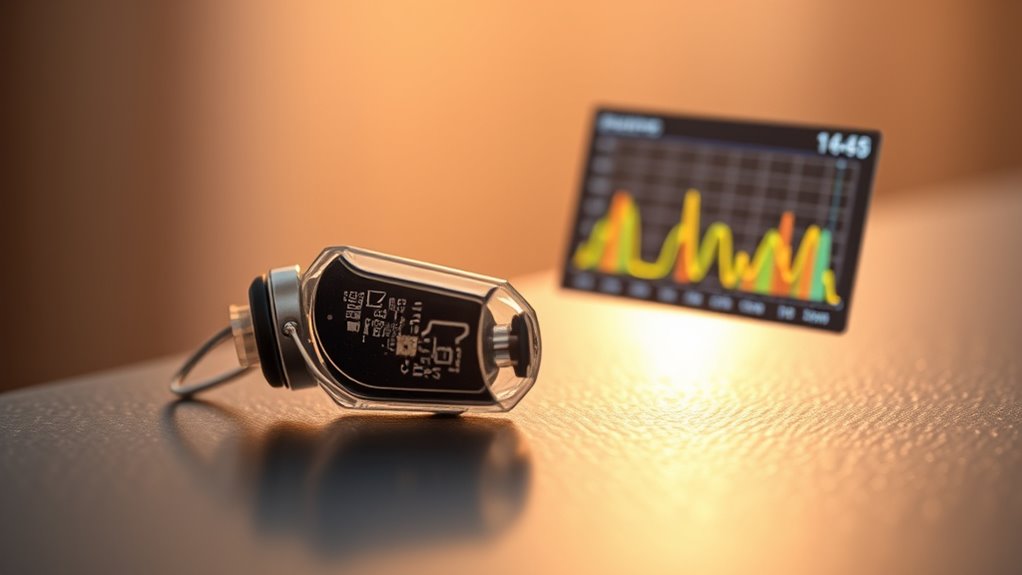
Frequency lowering offers unique benefits by making high-frequency sounds more accessible, but it works differently from features like noise reduction or directional microphones. Understanding how it compares helps you see which settings best suit your hearing needs. Plus, knowing how these features interact guarantees you get the most effective overall performance from your hearing aid.
Distinguishing Features and Benefits
Frequency lowering stands out among hearing aid features because it specifically targets high-frequency sounds that are difficult to hear, making speech clearer for users. Unlike amplification that simply boosts all sounds, frequency lowering enhances speech perception by shifting high-frequency sounds to lower, more audible ranges. This improves auditory resolution, helping you distinguish consonants and speech cues better. Key benefits include:
- Improved speech clarity, especially in noisy environments
- Better understanding of high-frequency consonants like “s” and “sh”
- Enhanced overall speech perception for clearer communication
Compared to other features, frequency lowering directly addresses the challenge of high-frequency hearing loss, offering targeted assistance that boosts how well you interpret speech. It’s a valuable tool for those needing sharper auditory resolution without overwhelming sound input.
Compatibility With Other Settings
While frequency lowering works effectively on its own, its compatibility with other hearing aid features is essential for optimizing your listening experience. When combined with noise reduction settings, it can better manage environmental noise, making speech clearer without sacrificing comfort. Adjusting for music appreciation, frequency lowering can help you enjoy melodies by preserving high-frequency harmonics, but it must work smoothly with other sound processing features. Compatibility ensures that settings like directional microphones and speech enhancement don’t conflict, maintaining a natural sound. Proper integration allows you to switch seamlessly between different environments, whether you’re enjoying music or steering through noisy places. Overall, ensuring these features work together maximizes the benefits of frequency lowering and enhances your auditory experience.
Choosing the Right Hearing Aid With Frequency Lowering Capabilities
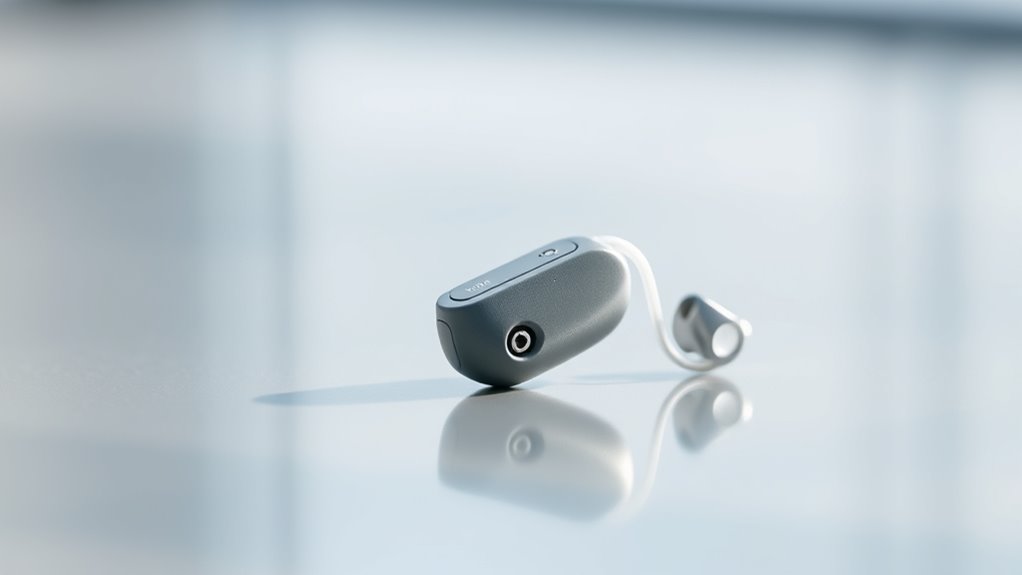
Choosing the right hearing aid with frequency lowering capabilities can substantially improve your ability to understand speech, especially in challenging listening environments. To select the best device, consider these factors:
Selecting a hearing aid with frequency lowering enhances speech clarity in tough listening situations.
- Customization Options: Guarantee the hearing aid allows personalized adjustments for music appreciation and tinnitus management, enhancing your overall experience.
- Sound Quality: Look for models that deliver natural sound with minimal distortion, so speech remains clear and music sounds rich.
- User Control: Choose devices with user-friendly controls to easily toggle frequency lowering settings based on your environment or needs.
Future Developments in Frequency Lowering Technology

Advancements in frequency lowering technology are paving the way for even more effective solutions that cater to diverse listening needs. Future developments aim to enhance auditory perception by refining how sounds are processed, making speech clearer and more natural. Researchers are working on algorithms that preserve sound quality while improving the ability to localize sounds accurately, which is vital for safe and effective sound localization. These innovations could include smarter, adaptive systems that adjust in real-time based on your environment, providing a more seamless listening experience. As technology evolves, you’ll benefit from devices that better preserve spatial cues and improve overall sound awareness. These improvements will help you enjoy richer, more precise auditory experiences, even in complex listening situations.
Frequently Asked Questions
Can Frequency Lowering Be Customized for Individual Hearing Loss Profiles?
Yes, frequency lowering can be tailored for your hearing profile. Manufacturers often offer individualized settings, allowing audiologists to adjust the technology based on your specific hearing loss. This hearing profile customization guarantees that the frequency lowering works effectively for you, improving speech clarity and sound quality. By tailoring the settings, you get a more personalized hearing experience, helping you better understand conversations and enjoy sounds more fully.
How Does Frequency Lowering Impact Background Noise and Speech Understanding?
Frequency lowering can help you hear speech more clearly by shifting high-frequency sounds downward. However, it might also affect how you perceive background noise, sometimes making it more noticeable or less distinct. Overall, this technology aims to improve speech clarity, especially in noisy environments. You may notice that background noise becomes less distracting, allowing you to focus better on conversations. Adjustments can be made to optimize both speech understanding and noise management.
Is Frequency Lowering Suitable for All Types of Hearing Loss?
This question is as important as choosing the right superhero costume! Not everyone with hearing loss benefits equally from frequency lowering. Hearing aids with this feature can improve sound quality for some, but it might not be suitable for all types of hearing loss. Consult your audiologist to determine if frequency lowering enhances your hearing experience or if other solutions might be better suited to your specific needs.
What Maintenance or Adjustments Are Required for Frequency Lowering Technology?
You’ll need to regularly maintain your frequency lowering technology by guaranteeing proper amplifier calibration and keeping software updates current. Calibration ensures the device functions at its best, while updates improve performance and fix bugs. Check with your audiologist periodically to confirm settings are correct, and ask about any new software releases. These simple steps help your hearing aids stay effective, comfortable, and tailored to your evolving hearing needs.
How Does Frequency Lowering Affect the Naturalness of Sound Perception?
Frequency lowering can impact the sound quality you perceive, sometimes making sounds seem less natural. It may improve your ability to hear high-frequency sounds, but it can also introduce artifacts or a robotic quality, affecting your listener experience. While it often enhances speech clarity, you might notice a slight change in the naturalness of sounds. Adjustments to the technology can help balance improved hearing with maintaining a pleasing, natural sound quality.
Conclusion
Understanding frequency lowering can truly turn the tide in your hearing journey. By bridging high-frequency gaps, it helps you catch every word and nuance. As technology advances, you’ll find more tailored solutions that fit your needs. Don’t let high-frequency loss hold you back—sometimes, you just have to seize the moment before it slips through your fingers. With the right hearing aid, you’ll be better equipped to embrace life’s sounds with confidence and clarity.




